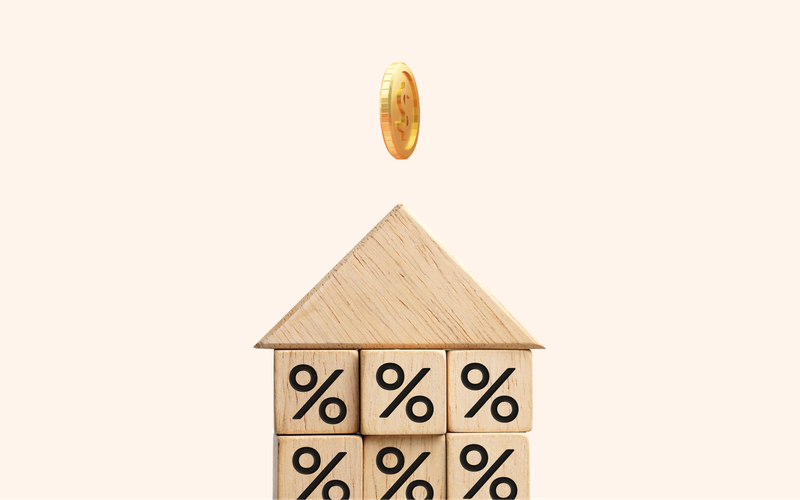Mortgage rates can significantly influence your real estate investment strategy and overall returns. But figuring out how mortgage rates are determined can feel complicated.
Here’s what you need to know.
Types of Mortgages and Their Interest Rates
When you’re looking to finance a property, there are several types of mortgages available, each with its interest rate structure:
Fixed-Rate Mortgages
These are the most straightforward mortgages. The interest rate remains the same throughout the life of the loan, which means your monthly payments are predictable. Fixed-rate mortgages can be long-term (15, 20, or 30 years) or short-term.
Adjustable-Rate Mortgages (ARMs)
These mortgages have interest rates that can change periodically based on market conditions. Typically, adjustable rate mortgages offer a lower initial rate than fixed-rate mortgages, but the rate adjusts at specified intervals (e.g., annually). This means your payments can fluctuate, affecting your budget.
Interest-Only Mortgages
With these mortgages, you only pay interest for a set period, usually 5-10 years. After the interest-only period ends, you start paying both principal and interest, which can significantly increase monthly payments.
FHA Loans
These government-backed loans require a lower down payment and are often easier to qualify for. They may require mortgage insurance.
VA Loans
Available to veterans and active military members, VA loans offer competitive rates and require no down payment, although eligibility requirements apply.
Factors Affecting Mortgage Rates
Several factors influence your mortgage rates, including:
- Credit Score: A higher credit score typically means a lower interest rate. Lenders often view borrowers with good credit as less risky.
- Loan Amount and Term: Generally, shorter-term loans often have lower interest rates than longer-term loans. However, larger loan amounts may also have higher rates.
- Down Payment: A larger down payment can reduce the lender’s risk and lower interest rates.
- Property Type: Investment properties or second homes usually have higher interest rates than primary residences due to their higher perceived risk of default.
- Market Conditions: Broader economic conditions and market trends play a significant role in determining mortgage rates.
How the Federal Reserve and the Economy Factor into Mortgage Rates
The interplay between the Federal Reserve’s actions and economic indicators is complex, but understanding this relationship is essential.
Federal Funds Rate
The Federal Funds Rate is a key tool the Fed uses to influence the economy. It’s the interest rate at which banks lend each other overnight. This rate affects the overall cost of borrowing and has a ripple effect on various types of loans, including mortgages. Here’s how it works:
- Direct Impact on Borrowing Costs: When the Fed changes the federal funds rate, it directly influences short-term interest rates. Banks typically pass on these changes to consumers through their loan and mortgage interest rates. For instance, borrowing costs increase if the Fed raises the federal funds rate, leading to higher mortgage rates. Conversely, a lower federal funds rate reduces borrowing costs, resulting in lower mortgage rates.
- Cost of Capital: Banks use the federal funds rate as a benchmark for setting the interest rates on other loans and financial products. When banks' capital cost increases (due to a higher federal funds rate), they may raise the interest rates on mortgages to maintain their profit margins. Lower federal funds rates decrease the cost of capital, leading to lower mortgage rates.
- Expectations and Speculation: Mortgage rates also respond to expectations about future changes in the federal funds rate. Lenders might increase mortgage rates in anticipation if the Fed signals that it plans to raise rates. Conversely, if the Fed indicates a future rate cut, mortgage rates might decrease even before the Fed acts.
Economic Indicators
The Fed uses various economic indicators to guide its monetary policy decisions. These indicators provide insights into the economy's overall health and help the Fed determine whether to adjust interest rates. Key indicators include:
- Inflation: Inflation measures the rate at which the general price level of goods and services rises. High inflation erodes purchasing power and can lead the Fed to increase interest rates to cool off the economy and prevent runaway inflation. Higher rates can lead to higher mortgage rates, making borrowing more expensive. On the other hand, if inflation is low, the Fed might lower interest rates to encourage borrowing and spending, which can lead to lower mortgage rates.
- Employment Rates: The Fed monitors employment rates and job growth as indicators of economic health. Low unemployment and strong job growth suggest a robust economy, which might prompt the Fed to raise interest rates to prevent the economy from overheating. Conversely, high unemployment or weak job growth may lead the Fed to lower rates to stimulate economic activity and job creation. Changes in employment rates can indirectly impact mortgage rates, as they influence broader economic conditions.
- GDP Growth: Gross domestic product (GDP) measures the total value of goods and services produced in an economy. Strong GDP growth indicates a healthy, expanding economy, which might lead the Fed to raise interest rates to manage inflation and avoid an overheated economy. Slower GDP growth or recessionary conditions might lead to rate cuts to stimulate economic activity. The economy's overall health, as reflected by GDP, affects consumer confidence and borrowing behavior, which in turn impacts mortgage rates.
Monetary Policy Goals
The Fed’s monetary policy aims to achieve a balance between promoting economic growth and maintaining price stability. This balance affects mortgage rates in the following ways:
- Inflation Control: The Fed uses interest rates to control inflation. By raising rates, the Fed makes borrowing more expensive, which can reduce spending and slow down inflation. This, in turn, impacts mortgage rates, as lenders can adjust their rates based on the cost of borrowing. Lower inflation, often achieved through lower rates, can make mortgages more affordable.
- Economic Stimulus: During periods of economic downturn or slow growth, the Fed may lower interest rates to stimulate borrowing and investment. Lower rates encourage consumers to take out mortgages and buy homes, which can boost the real estate market. This increase in demand can also affect property values and investment returns.
- Financial Stability: The Fed also considers financial stability when setting rates. Rapidly changing rates can lead to market volatility, which can affect mortgage markets. The Fed aims to manage rate changes to minimize disruption to financial markets and the broader economy.
Inflation and Mortgage Rates
Inflation and mortgage rates are intricately linked, with inflation often driving changes in interest rates set by the Federal Reserve. Understanding this relationship is crucial for both homeowners and real estate investors. Here’s an expanded look at how inflation affects mortgage rates and what that means for real estate investment.
High Inflation and Mortgage Rates
Federal Reserve Response:
- Interest Rate Hikes: When inflation rates rise, the Federal Reserve typically responds by increasing the federal funds rate, which can raise overall borrowing costs. The rationale is to combat inflation by reducing consumer spending and borrowing, which can help cool an overheating economy.
- Cost of Borrowing: As the Fed raises rates, borrowing costs can increase across the board. This includes mortgages, as lenders adjust their rates in response to higher short-term borrowing costs. For prospective homebuyers and investors, this translates into higher mortgage rates.
Impact on Mortgage Payments:
- Higher Monthly Payments: Higher mortgage rates mean monthly payments on new loans or adjustable-rate mortgages can increase. This can reduce disposable income for borrowers and limit their ability to take on new debt or make large purchases, including real estate.
- Affordability: Higher monthly payments can affect home affordability, leading to a slowdown in the housing market. This can reduce property demand and potentially lower home prices, affecting property values and investment returns.
Impact on Real Estate Investors:
- Increased Financing Costs: High inflation and rising mortgage rates can mean higher financing costs for real estate investors. This can reduce the profitability of investment properties, mainly if investors rely on borrowed funds to finance their purchases.
- Lower Returns: The increase in borrowing costs can lead to lower net operating income (NOI) and reduced return on investment (ROI). Investors might find meeting cash flow requirements and achieving desired financial outcomes more challenging.
Lower Inflation and Mortgage Rates
Federal Reserve Response:
- Interest Rate Cuts: When inflation is low or falling, the Fed may reduce the federal funds rate to stimulate economic activity. Lower rates are intended to encourage borrowing and spending by making credit cheaper.
- Cost of Borrowing: Lower interest rates can reduce the cost of borrowing for consumers and businesses alike. In response, mortgage rates typically decrease, making home loans and real estate investments more affordable.
Impact on Mortgage Payments:
- Lower Monthly Payments: Reduced mortgage rates result in lower monthly payments for new loans or adjustable-rate mortgages. This can make it easier for buyers to afford homes and for investors to finance properties.
- Increased Affordability: Lower mortgage rates enhance home affordability, which can stimulate demand in the housing market. This increased demand can drive up property prices and potentially lead to appreciation in real estate values.
Impact on Real Estate Investors:
- Reduced Financing Costs: Lower mortgage rates can decrease financing costs for investors, which can improve cash flow and profitability. Investors may benefit from lower monthly payments and better loan terms.
- Increased Profit Margins: Reduced borrowing costs can lead to higher profit margins on rental properties or flips, making it easier for investors to achieve favorable returns on their investments.
Investment Opportunities:
- Expanding Opportunities: A low-rate environment can open up new investment opportunities, as investors may be more willing to explore different types of properties or take on more ambitious projects. Lower rates can also make securing financing for larger or more speculative investments easier.
Inflation and Economic Conditions
- Inflationary Pressures: High inflation can erode purchasing power and lead to economic instability. In such environments, the Fed’s rate hikes aim to bring inflation under control, but they can also have broader implications for economic growth and real estate markets.
- Deflationary Pressures: Low inflation or deflation can signal weak economic conditions. In such cases, lower interest rates can be used to stimulate economic activity. While this can benefit borrowers, it can also indicate underlying economic challenges that might affect real estate markets.
Long-Term Considerations
- Historical Trends: Mortgage rates have historically fluctuated in response to changes in inflation. Consider long-term trends and economic cycles when planning your investment strategies.
- Future Outlook: Monitoring inflation forecasts and Federal Reserve statements can help you anticipate changes in mortgage rates. This foresight can help guide investment decisions and strategy adjustments.
How Mortgage Rates Affect Real Estate Investing
Mortgage rates are a critical factor in real estate investing for several reasons:
- Financing Costs: Lower mortgage rates can reduce the cost of financing, which can increase cash flow and profitability. Conversely, higher rates can increase the cost of borrowing, potentially decreasing your return on investment (ROI).
- Property Values: Lower mortgage rates can make homes more affordable for buyers, driving up property values and increasing your investment's worth. However, higher rates might dampen demand and lead to stagnation or decline in property values.
- Investment Strategy: In a low-rate environment, it might be advantageous to leverage financing more aggressively, while in a high-rate environment, you might focus on properties that offer higher yields or explore alternative investment strategies.
Understanding mortgage rates is essential for real estate investors, as these rates affect financing costs, property values, and overall investment returns. Investors can make more strategic decisions by staying informed about the factors influencing mortgage rates, including the Federal Reserve’s policies and inflation trends. Whether investing in traditional real estate or exploring fractional ownership, keeping an eye on interest rates can help you optimize your investment strategy and navigate the market effectively.









